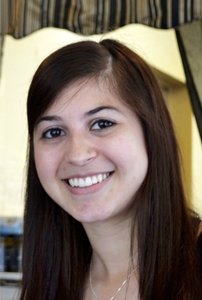Q&A with Nursing Student and STAR Scholar Rachel Pagano
October 15, 2014
 Current senior nursing student Rachel Pagano was fortunate enough to work as a Drexel STAR (Students Tackling Advanced Research) Scholar during her freshman year at Drexel. The highly selective program allows students to work full-time participating in faculty-mentored research, scholarship, or creative work. Pagano’s work as a STAR Scholar involved research around how sensory stimuli in an emergency room can affect the treatment of people with autism spectrum disorder (ASD).
Current senior nursing student Rachel Pagano was fortunate enough to work as a Drexel STAR (Students Tackling Advanced Research) Scholar during her freshman year at Drexel. The highly selective program allows students to work full-time participating in faculty-mentored research, scholarship, or creative work. Pagano’s work as a STAR Scholar involved research around how sensory stimuli in an emergency room can affect the treatment of people with autism spectrum disorder (ASD).
Chartings: Did you have experience related to ASD prior to working on this research project?
Rachel Pagano: Prior to doing research about Autism spectrum disorder with Dr. Giarelli, I used to work with a family friend who had ASD. Once a week, I would go to their house for an hour or so to interact with him in an attempt to improve his social skills.
Chartings: Tell us a bit about your ASD research as a STAR Student.
Pagano: During my time in the STAR Program, I researched how ASD affects people (for example, some people prefer hyper stimulation of their senses, so they will make loud noises, whereas others do not like loud noises). I spent time in an Emergency Department measuring the light intensity and noise levels for us to later assess the potential effects they may have on the care for patients with ASD.
Chartings: That sounds interesting! What did you gain from the experience?
Pagano: I found the research very interesting. Prior to starting the STAR program, I only had basic knowledge about autism spectrum disorder. After working with Dr. Giarelli, I gained a deeper understanding of what ASD is and how it affects not only the person who has it, but also the healthcare workers responsible for caring for these patients.
Chartings: What did you find surprising, if anything, about the research?
Pagano: Learning that ASD is not necessarily a straight-forward disorder piqued my interest. We typically learn that people affected by ASD have problems in social settings. However, autism is a spectrum disorder, so one person with ASD can be completely non-verbal, while another person can be able to hold a conversation. The fact that every person with ASD is affected differently by the disorder is what makes it so appealing to learn about.
Chartings: How do you think the research could impact the treatment of those with ASD?
Pagano: In nursing school, autism spectrum disorder is a topic that is brushed upon briefly in one class. When encountering a patient diagnosed with ASD, a nurse may not understand the special needs of this patient, which can create a hindrance in their care. When healthcare workers gain a better understanding of how to go about treating ASD patients with other ailments, the treatment process will not only be easier for the patient, but for those involved in their care, as well.
Chartings: Do you have any advice for students looking learn more about ASD?
Pagano: My advice to fellow students looking into doing similar research is to keep your mind open-- there is always so much more to learn. I initially applied to do the ASD research with Dr. Giarelli because I had previous experience with a person who has ASD. Throughout the research process, however, I gained so much more knowledge about the disorder and how it can affect the person diagnosed as well as their caretakers. Rather than thinking about what you already know, seek to understand what you don't yet know.
Please join us for our conference on November 8, 2014, Creating Integrated Healthcare Services for People with Autism Spectrum Disorder. Click here for conference information and to register.